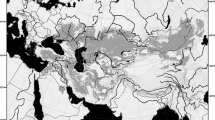Abstract
It seems probable that there are more species (in the sense of sharply diagnosable entities) than hitherto recognized among small Asian primates, and contrasting to some degree with larger-sized taxa. This presumably relates to their lesser vagility and consequent reduced potential for gene-flow. Even where some gene-flow can be demonstrated, as betweenNycticebus coucang andN. bengalensis, this appears to be very limited and does not affect the essential homogeneity and diagnosability of the two taxa.
The biogeographic implications of the taxonomic findings of this study are noteworthy. They confirm the distinctness of Sulawesi in contrast to a Sundaland/southern Philippines link (Tarsius); the separation of the Indochinese and Sundaic faunal subregions (Nycticebus); and the uniqueness of the Sri Lankan “wet zone” (Loris). Much more work needs to be done on all three genera, but their great taxonomic interest, indicating much greater complexity than previously assumed, is apparent.
Similar content being viewed by others
References
Beard, K. C.;Tao, Qi;Dawson, M. R.;Benyue, Wang;Chuankuei, Li. 1994. A diverse new primate fauna from middle Eocene fissure-fillings in southeastern China.Nature, 368: 604–609.
Feiler, A. 1990. Ueber die Säugetiere der Sangihe- und Talaud-Inseln- der Beitrag A. B. Meyers für ihre Erforschung (Mammalia).Zool. Abhandlungen Staatliches Museum für Tierkunde in Dresden, 46: 75–94.
Ginsburg, L.;Mein, P. 1987.Tarsius thailandica nov. sp. premier Tarsiidae (Primates, Mammalia) fossile d'Asie.Comptes Rendus de l'Académie des Sciences Paris, II, 304: 1213–1215.
Goonan, P. M.;Groves C. P.;Smith, R. D. 1995. Karyotype polymorphism in the Slender Loris (Loris tardigradus).Folia Primatol., 65: 100–109.
Groves, C. P. 1971. Systematics of the genusNycticebus. In:Proceedings of the Third International Congress of Primatology, Zurich, 1970, 1: 44–53.
Hill, W. C. O. 1933. A monograph of the genusLoris.Spolia Zeylanica, 18: 89–132.
Hill, W. C. O. 1952.Primates: Comparative Anatomy and Taxonomy. Strepsirhini. Edinburgh Univ. Press, Edinburgh.
Hill, W. C. O. 1953. Notes on the taxonomy of the genusTarsius. In:Proceedings of the Zoological Society of London, 123: 13–16.
Hill, W. C. O. 1955.Primates: Comparative Anatomy and Taxonomy. Haplorhini: Tarsoidea. Edinburgh Univ. Press, Edinburgh.
Manna, G. K.;Talukdar, M. 1968. An analysis of somatic chromosomes of both sexes of two primates, the slender loris,Loris tardigradus and rhesus monkey,Macaca mulatta, Mammalia, 32: 118–130.
Musser, G. G.; Dagosto, M. 1987. The identity ofTarsius pumilus, a pygmy species endemic to the montane mossy forests of Central Sulawesi.,Amer. Museum Novitates No. 2867.
Nemitz, C.;Nietsch, A.;Warter, S.;Rumpler, Y. 1991.Tarsius dianae: a new primate species from Central Sulawesi (Indonesia).Folia Primatol., 56: 105–116.
Author information
Authors and Affiliations
About this article
Cite this article
Groves, C. Systematics of tarsiers and lorises. Primates 39, 13–27 (1998). https://doi.org/10.1007/BF02557740
Received:
Accepted:
Issue Date:
DOI: https://doi.org/10.1007/BF02557740




